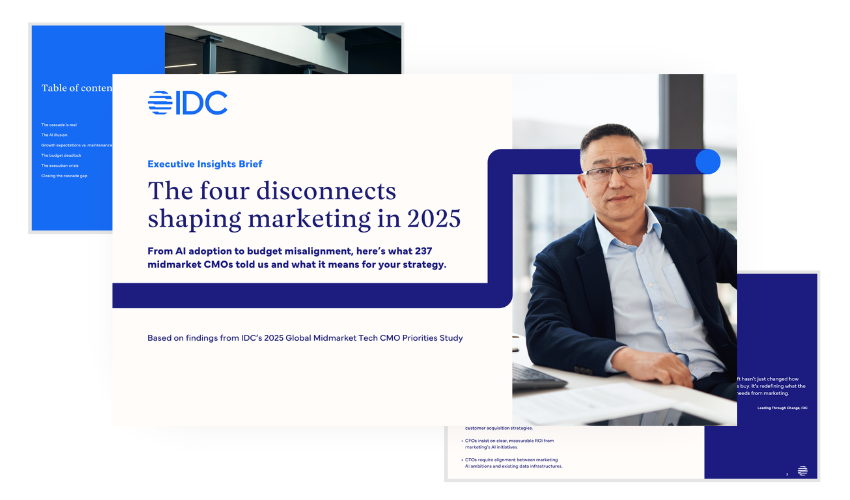The acronym CMO has traditionally stood for “Chief Marketing Officer,” but that role is evolving. The need for today’s midmarket CMOs to lead with clarity and vision is more important than ever.
A third of midmarket CMOs expect to take on the new title of Chief Market Officer, according to IDC’s 2025 Global Midmarket Tech CMO Priorities Survey. This shift signals broader leadership responsibilities, a deeper understanding of the market, and a central role in driving business growth.
But as the expectations placed on CMOs continue to rise, many are facing critical disconnects between what is expected of them and what they’re currently equipped to deliver.
Unlock the secret to securing marketing’s role as an essential growth driver. Download IDC’s Executive Insights Brief: The four disconnects shaping Marketing in 2025 to learnmore about the challenges facing today’s midmarket CMOs – and thirteen achievable steps to overcome them.
The misalignment between exekutive expectations and marketing realities
The Pressure Cascade CMO’s are facing highlights a growing challenge: rising executive demands for innovation, AI-driven strategies, and customer acquisition are colliding with limited resources and skills gaps within marketing teams.
CMOs must act decisively to address these issues and secure their role as essential growth drivers within their organizations. Failure to do so risks diminishing marketing’s strategic relevance – and potential for transformation.
IDC has identified four critical disconnects holding back midmarket CMOs. Addressing these gaps is not only necessary, it’s urgent.
Disconnect 1: The illusion of AI adoption
Many midmarket organizations believe they’ve adopted AI, but in reality efforts are fragmented and lack the necessary infrastructure and talent to scale. According to IDC’s MaturityScape Benchmark AI Survey, most companies remain in the “AI Pivot” stage, despite their beliefs that they’re further along in the AI journey.
While individual AI tools or pilots may be in place, they often lack a cohesive, strategic approach that aligns with broader business objectives. This gap between perceived and actual AI maturity leaves marketing teams underprepared to capitalize on AI’s full potential.
Why this can’t wait
CMOs who fail to address these challenges risk falling behind competitors who are fully integrating and leveraging AI to drive innovation and growth. Without a unified AI strategy, marketing can’t deliver on its transformative potential, leaving the organization at a competitive disadvantage.
How you can lead
By lifting the AI illusion and closing the gaps in AI adoption, you establish marketing as a central driver of innovation and growth. This is your chance to step into a leadership role and show that marketing isn’t just a function but a catalyst for long-term success.
As you fully integrate AI into your marketing strategy, you position your team to lead the charge in personalizing customer experiences, optimizing processes, and making data-driven decisions that directly contribute to business growth.
Disconnect 2: Growth expectations vs. maintenance realities
While the C-suite expects marketing to drive customer acquisition and fuel business growth, many CMOs continue to focus on retention and efficiency, according to the IDC Midmarket Survey.
Marketing leaders are prioritizing existing customer relationships and cutting costs, rather than aggressive executive growth strategies. This disconnect between corporate objectives and marketing’s internal goals limits CMOs’ ability to lead strategically.
Why this can’t wait
The pressure to drive growth is intensifying. CMOs who fail to align marketing’s efforts with executive expectations risk losing the confidence of the C-suite. When marketing remains focused on maintenance, it misses out on new market opportunities and limits its impact on the organization’s growth trajectory.
Without a strategic shift toward customer acquisition and new business development, CMOs risk being viewed as supporting players rather than transformation leaders, diminishing their organizational authority.
How you can lead
Position your department as a leader in expansion by shifting your focus toward growth, aligning marketing strategies with the C-suite’s expectations. This shift enables you to actively contribute to new revenue streams and enhance your organization’s competitive position.
With strategic rebalancing, marketing becomes a key player in achieving measurable business growth, firmly establishing your leadership role and delivering on your department’s potential for transformation.
Disconnect 3: The budget deadlock
As marketing teams are tasked with delivering high-impact results across the board, many CMOs face the reality of flat or insufficient budgets. More than half of CMOs expect no increase to their budget, found the IDC Midmarket survey.
This disconnect occurs when marketing is expected to drive tomorrow’s growth with yesterday’s financial resources, hindering the ability to invest in the necessary tools, technology, and talent. The added challenge of quantifying marketing’s value can frame it as a cost center rather than a revenue generator.
Why this can’t wait
Without the financial flexibility to execute growth strategies, marketing will struggle to meet rising executive demands. The inability to allocate resources to high-ROI initiatives such as AI, customer acquisition, and digital transformation will lead to missed opportunities. This disconnect can quickly erode marketing’s credibility and relevance within the company – and the market.
How you can lead
You can prove marketing’s worth as a driver of organizational growth by addressing the budget disconnect and securing the resources you need to act, not react.
With the right resources to execute your strategic vision, you’ll be empowered to develop initiatives to drive proactive AI integration, customer acquisition, and improved customer experiences – becoming an essential partner in business growth and demonstrating critical leadership value.
Disconnect 4: The execution crisis
Midmarket CMOs recognize the importance of orchestrating complex, AI-powered customer journeys and delivering personalized experiences, but many struggle with the execution. In fact, upskilling and hiring were found to be low priorities for marketing leaders who responded to the Midmarket survey.
Without the right infrastructure and talent, even the most well-conceived strategies will fall short, limiting marketing’s ability to execute at the scale required to meet organizational objectives.
Why this can’t wait
As expectations for marketing continue to grow, failure to close the execution gap poses a serious risk. Ineffectively executed strategies lead to missed opportunities, fragmented customer experiences, and eroded executive trust.
In an increasingly competitive market where speed and agility are crucial, organizations that cannot execute swiftly and effectively will be outpaced by competitors. The execution crisis jeopardizes marketing’s ability to deliver measurable, timely results, weakening its strategic position.
How you can lead
By overcoming the execution crisis, you establish marketing as a results-driven function that consistently achieves wins. Building clear operational frameworks, defining roles, and empowering skilled teams ensure your marketing initiatives can be executed effectively and at scale.
This transformation enables marketing to lead with precision, translating strategic visions into impactful business outcomes and solidifying your role as a critical driver of organizational success.
Reconnect the disconnects and become a leader
The four disconnects aren’t just operational challenges: They’re strategic barriers preventing marketing from reaching its full potential. As a CMO, now is the time to step up and lead.
By addressing these disconnects head-on, you can transform marketing from a perceived support function to a recognized driver of growth and innovation.
The ability to successfully overcome these gaps will help you make the leap from Chief Marketing Officer to Chief Market Officer: an authority who not only meets the rising expectations of the C-suite but shapes broader market trajectories.
The urgency to resolve these disconnects is more than just about staying competitive. It’s about asserting marketing’s place at the heart of business transformation. The time to act is now.
Are you ready to fully align your marketing strategy with executive demands? Learn more about the four disconnects shaping marketing and unlock 13 proven strategies for bridging these critical marketing disconnects and lead with confidence.





